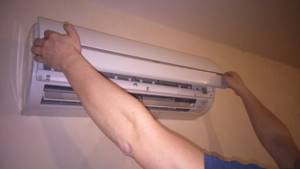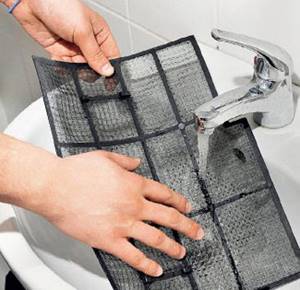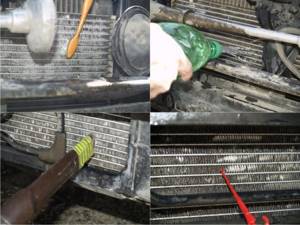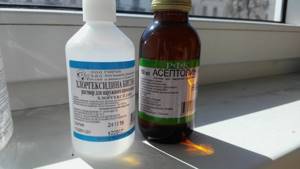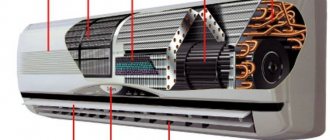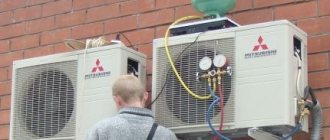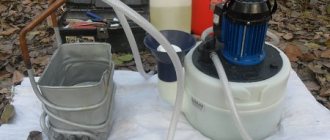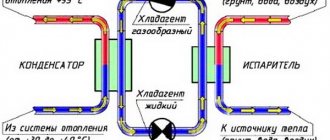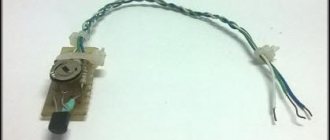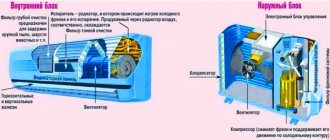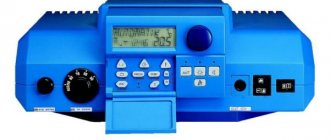What to expect from dirty filters
The degree of contamination of home air conditioner filters determines not only the efficiency of its operation, but also the quality of the air itself. Let's list the main negative consequences of dirty filters. The air conditioner performs its functions much worse. In other words, in the summer it will not cool the air so well, and in the winter it will not heat it well. Accordingly, other functions, be it dehumidification or air circulation, will be performed ineffectively.
The air conditioner will last less. If you ignore filter cleaning, the device, due to reduced efficiency, will work longer before reaching the set temperature parameters and, accordingly, will exhaust its service life faster. Due to deterioration in heat transfer, the climate system will overheat and may fail, and the breakdown may be either minor or require a complete replacement of the compressor.
Emits unpleasant odors. Passing through clogged filters, the air absorbs and accumulates its aromas, which do not cause delight when you turn on and use the device. Especially the smells of cooking and pets.
The filter becomes a breeding ground for bacteria and is harmful to health. It should be remembered that filters are clogged not only by mechanical particles, but also by various microorganisms, bacteria, viruses, etc., which is why entire colonies of similar residents are formed in them. And some, such as mold and mildew, grow and multiply due to increased humidity while the system is operating in cooling mode. After all, at the moment of cooling, the moisture in the air condenses on the heat exchanger and flows into the drainage hose. Dust, absorbing moisture, creates ideal conditions for the growth of these uninvited guests.

In the end, this will lead to a significant portion of them getting into the air, mostly mold spores, which negatively affect the health and well-being of a person in general. Young children and the elderly, as well as anyone with respiratory problems, are especially susceptible to such effects.
Excessive noise and a wet spot under the air conditioner. When the filters become too dirty, they create quite a significant resistance to the passage of air, and therefore the noise level from the fan increases.
If the filters are heavily clogged, the block may freeze and condensation may form on the plastic housing; when it accumulates, it drips directly onto the floor or flows down the wall, with all the ensuing consequences.
When is cleaning needed?
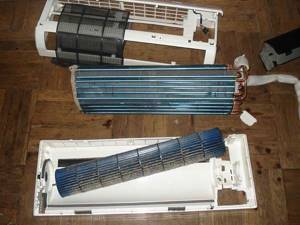
The dust that accumulates in your air conditioner can not only cause a deterioration in the quality of its operation, but also cause a breakdown. The following indicates that the split system needs cleaning:
- The microclimate in the room has deteriorated significantly - this will be especially noticeable by people suffering from dust allergies. This happens due to the fact that the system blows the dirt particles accumulated in it around the room.
- The device began to cool the air in the room much more slowly - due to the fact that dust enveloped the heat exchanger.
- It feels like it’s hard for the air conditioner to work - it can hum, squeak, and circulate air with a lot of noise.

Untimely cleaning or lack thereof will lead to serious problems in the operation of the device:
- contamination of the internal module;
- reducing radiator airflow;
- difficult cleaning of heavily soiled filters;
- contamination of the drainage system, which inevitably results in freon leakage.
Advice! The filter can be washed no more than 8 times, after which it needs to be replaced! Exposure to water worsens the throughput of the element, which can lead to deterioration of the performance of the entire air conditioner as a whole.
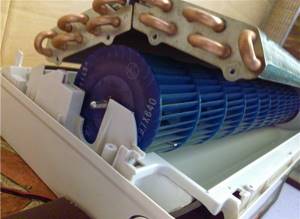
This is what the fan looks like...
How to clean air conditioner filters yourself

- Gently pull the front panel of the indoor unit towards you, grasping the special finger ledges located at the ends of the lower part of the front panel, on the left and right sides.
- By lifting the cover, it can be locked in the open position, in the places where it is attached to the body of the unit itself. Under the front panel there are two identical filters covering the heat exchanger. In addition to air purification, the function of the filter is to protect the heat exchanger and fan impeller from clogging and dust accumulation. Cleaning it is much more difficult; for this you will need a steam cleaner and active foam, and it will take at least an hour. While washing the filter will take no more than 5 minutes.
- Remove the filter, rinse it with water at room temperature (maybe a little warmer, but not hot). If desired, treat it with a cleaning agent, or even better, with an antibacterial effect, which can be purchased at any pharmacy. Thanks to this, it will be possible not only to improve the cleaning quality, but to get rid of the unpleasant odor.
- Dry the filter, then install it in its place and close the front panel.
- We recommend inspecting the heat exchanger and, if necessary, at least carefully vacuuming it without bending the soft fin plates.
Important: Do not forget that cleaning the air conditioner is not limited to just maintaining the filters. The external unit of the split system also deserves attention. It becomes intensively clogged in the summer, especially during the flowering period of poplars. It also experiences high loads in the fall, when the leaves fall. Various industrial emissions, such as car exhaust, also have a significant impact on it. In addition to cleaning, there are other necessary service work for caring for a home air conditioner, which only qualified specialists can perform.
Cleaning
First of all, we will look at the stages of cleaning a split system.
Step-by-step cleansing
Let's look at the table for step-by-step cleaning of the device - how to wash the air conditioner.
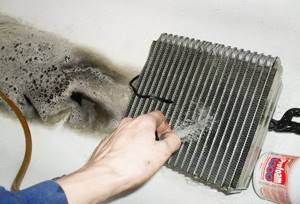
Cleaning the heat collector
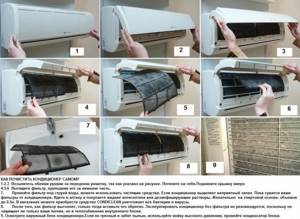
Cleaning the filter clearly
| Preparatory stage
| 1. It would be a good idea to read the operating instructions for the device - perhaps there you will see a clear algorithm for cleaning your particular air conditioner. But the main thing is that you need to know the type of split system filter and how you can clean or replace it. 2. If the device has not been cleaned for a long time, be sure to cover the area near it with newspapers, large polyethylene or old cloth, since dust can literally fall out of the system. 3. Be sure to disconnect the air conditioner from the power source before flushing the air conditioning system! |
| Cleaning (replacing) the filter
| 1. Open or temporarily dismantle the “container” cover. This is done using a similar method for all devices - pull the part towards you, grasping its right and left sides with your hands, and then push it slightly upward. 2. Remove the special protective grille, which protects the filter from damage and securely fixes it. Grab the bottom of it and pull upward slightly. Feeling the pliability of the part, lower it down and then towards you. 3. Now you need to carefully remove the grille with the filter. 4. Clean it thoroughly with a vacuum cleaner or dry brush. 5. The next step is to rinse the filter in cold running water. If it is very dirty, then you should soak it for a while in a soapy solution, and then rinse it under high pressure water. Aggressive cleaning agents are not recommended! 6. Dry the element naturally, without any exposure to heat. Otherwise, it can easily become deformed. 7. Only mesh filters can be cleaned. Pocket ones will only have to be replaced with new ones. 8. After the filter has completely dried, reassemble all components in the reverse order, connect the power cord to the outlet - the device is ready for use. |
| Cleaning the heat exchanger-evaporator of the internal module - structures that are tubes in which freon evaporates. This process significantly cools the internal module itself, as well as the air flows passing through it.
| The evaporator heat exchanger is an important part of your split system. Therefore it must also be free of dust and ideally absolutely clean. How to flush the air conditioner radiator yourself? Cleaning it is absolutely simple: 1. Disconnect the air conditioner from the power supply. 2. Open its lid and remove the protective grille - exactly as the device manufacturer’s instructions advise. 3. Heat exchanger, the space between the tubes can be removed from dust using a vacuum cleaner, and also cleaned with a narrow brush. Avoid metal and hard brushes - they can damage the element, which will cause freon leakage. 4. If dust combines with condensation and turns into a kind of dirt film, then only a steam cleaner can remove it. 5. Reassemble the components in reverse order. That's all that can be said about how to wash the air conditioner radiator. |
| Cleaning the outdoor unit
| Approach this procedure with caution! We urge you to refuse it if you live in a multi-storey building - the risk is not worth paying for the work of a team of specialists. In other cases, cleaning can be done according to the following algorithm: 1. Unplug the device from the outlet. 2. Using a damp cloth and brush, remove all dirt accumulated on the surface of the housing. 3. Connect a long hose to the water tap or use a special car washing device that releases a stream of water under pressure - you need to thoroughly rinse its contents without opening the casing of the external unit. A steam cleaner is also good for this type of washing. 4. Remove excess water with a cloth and allow the device to dry thoroughly. 5. After all the procedures, the air conditioner is ready to work again! |
| Cleaning the drainage system
| A drainage system contaminated with dust, grease, dirt, and sometimes even mold and mildew is fraught with the fact that water from it begins to flow not from the outside of the wall, but into the room. And mold tends to grow on the drainage pan, and then on the heat exchanger, and on the inner walls of the air conditioner. Cleaning it is no more difficult than cleaning an air conditioner evaporator: 1. Dilute a soap solution or dishwashing liquid. 2. Using a small brush, thoroughly clean the inside of the tube. 3. The final step will be to wash the drainage pan with the same soap solution. |
The only necessary procedure that we do not advise you to do yourself, when you need to wash the air conditioner yourself, is washing the fan of the internal module - something like a roller with peculiar “membranes”. It is needed to ensure that cooled air is dispersed throughout the room.
If dust completely clogs its membranes, it simply won't be able to do its job and your air conditioner will become useless. The procedure for cleaning it is very specific for a non-professional, and if you do not have the proper skills, you can easily break the element.
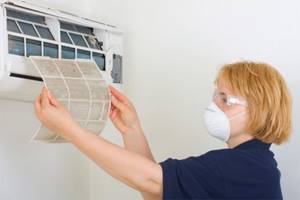
Consider your own dust protection
But if you are confident in your abilities, then we offer you the simplest and most effective method of flushing a split system fan:
- Protect the wall and floor near the fan from flying cleaning products with large polyethylene, old oilcloth or other waterproof material.
- Disconnect the device from the network, open the air conditioner cover, remove all removable interfering elements.
- How to rinse the air conditioner yourself? Dilute the soap solution and apply it with a sponge to the fan partitions. Leave them to “soak” for a while.
- Connect the fan to a power source and turn on “light mode”. The air will pass through the fan partitions and blow away soaked scraps and pieces of dust and dirt.
- After a few minutes, when everything possible has flown out, turn off the air conditioner again and unplug it from the outlet.
- Time for mechanical cleaning with your own hands - use a brush or a small brush dipped in a soap solution to complete the work following air flows.
- Wait until the fan dries, then reassemble the components in the reverse order, close the lid - the device can be used!
The video in this article will clearly demonstrate the process of cleaning the air conditioner.
Alternative cleaning
Time does not stand still, so we will introduce you to revolutionary new methods that tell you how to flush your home air conditioner:
- Foam-aerosol washing. Through a narrow tube, the product is poured into the system’s deflectors. Then 15 minutes are given to distribute it among the elements. Next, cold ventilation is turned on - the air conditioner operates in this way for up to 5 minutes. And then the “cond” is cleaned: the evaporator is washed, microorganisms are destroyed.
- Aerosol washing. The device is turned on at minimum speed, and the spray is sprayed specifically onto the “honeycombs” of the evaporator, smoothly and evenly. After you have sprayed all the products, you need to turn on the warm mode. So the split system should work for another 10 minutes. As a result, we get a thorough cleaning of the evaporator and air ducts, as well as their disinfection.
- Remedy from WYNN's (pictured). It is necessary to select a mode in which the fan operates at full power and the cooling system does not function. Then “pour” the substance into the ventilation hole, using the entire can. After 15 minutes, the air conditioner will be ready for normal operation.
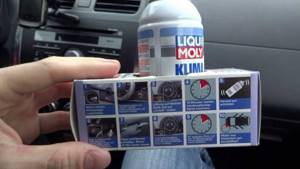
Aerosol for cleaning. Suitable for car air conditioners

How to wash the air conditioner - do not forget about regular peroxide
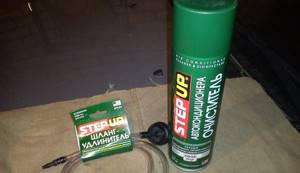
Foam cleaner

Special disinfectant

Organic cleaning

Remedy from WYNN's
Tips and operation
We will introduce you to a number of recommendations that will help keep your air conditioner in perfect condition for as long as possible:
- Cleaning is only half the guarantee of trouble-free operation of the air conditioner. It is also important to use it correctly and carefully - be sure to close the windows when the device is operating, give it time to “rest”, turn it on/off only using the remote control or special buttons on the case, and not by unplugging the cord from the socket.
- Before all cleaning procedures, be sure to turn off the device from the network!
- Clean the device with soft tools - brushes and brushes, soft cloth, napkin.
- To prevent mold and mildew from forming inside the device, it must be disinfected at least twice a year. For these purposes, a special liquid for washing air conditioners is produced. However, an equivalent replacement would be a regular antiseptic hand spray or another sprayable disinfectant solution containing alcohol. Ideally, you need to spray at least 500 ml of solution at a time. To do this, open the air conditioner cover, remove the protective grilles and filters. Turn on the device, selecting the maximum airflow, but the minimum temperature. Observe where the air is sucked in - the liquid should be sprayed into this area. Let the device work in this way for ten minutes. Don't worry if it smells bad during this time. Then turn off the air conditioner, wipe it with a soft cloth if necessary, return all the elements to their place and close the lid.
- It is better, as they say, “to see once than to hear a hundred times.” Invite specialists to work that you don’t understand. Observe their actions carefully and do not hesitate to ask questions. This is what will help you carry out subsequent cleanings yourself.
That's all we wanted to tell you about washing air conditioners. When developing a certain skill, this is a fairly simple procedure. However, in order to start it, you need to have a clear example of the correct actions before your eyes.
How often should air conditioner filters be maintained?
Conventionally, it is believed that filters should be cleaned once a month. However, this is a very rough guideline, suggesting certain average conditions under which the device will operate. If the air conditioner operates in a heavily polluted industrial area, and is also subjected to heavy loads from the inside (smoky room, kitchen, pets, etc.), then the filters may become clogged within a week.
But if the conditions are diametrically opposite, and you live outside the city, and the air conditioner is installed, for example, in a children's room, then the filters may require cleaning only after a few months or even six months. In any case, this can only be found out experimentally, so don’t be lazy to look inside - over time you will understand which frequency is optimal.
In any case, you should not accumulate dust and bring the condition of the internal parts of the air conditioner to a general cleaning, as in the photo below. Cleaning such a dirty device will be very expensive, at least 5,000 rubles. Although these are flowers compared to the air the users of this air conditioner breathed.
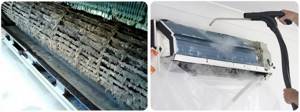
In conclusion, it should be said that cleaning the filters is perhaps the most important part of maintaining a split system. However, if you don’t want to do this, you can order air conditioner service in the “Equipment for Comfort” online store; prices for our services can be found here. The advantage of this solution is that, as a rule, this service is accompanied by others, for example, preventive diagnostics of parameters will be carried out, if necessary, filling the system with freon, checking the tightness of pipeline connections and other important work that will extend the life of your air conditioner.
We recommend: New generation ceramic heater - operating principle and advantages, types and popular models
Note: It is recommended to carry out preventive maintenance work on the split system at least once a year.
Although for a home air conditioner this interval can be doubled or even tripled, depending on how often and under what conditions the climate system operates.
How often should you clean the air conditioner in your apartment?
The very first thing is to remove the front (front) panel of the indoor unit, and you will understand everything. It is very easy to remove - it is attached with latches. Of course, during periods of intensive use, the air conditioner becomes dirty faster.
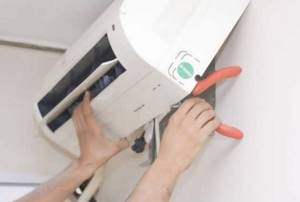
In the summer, when it’s hot, the device works almost around the clock for cooling, in the winter for heating (or rather in the fall, when the heating has not yet been turned on, and in the spring it is still cold and has not been turned off). In severe frosts (-10, 15, 20 °C - depending on the model), you cannot turn on the air conditioner - the oil will thicken and the compressor will “fly”, and it costs almost half the cost of the entire air conditioner.
So, at the peak of use, in the summer, the coarse filter in the indoor unit needs to be washed at least a couple of times a month. A fan, fine filters, heat exchanger, and drainage system are only possible before and after the season (so-called deep cleaning). The same goes for the external unit.

Dirty indoor unit
Unscheduled cleaning may be necessary if:
- The air conditioner works, but cools/heats less efficiently in the same mode or begins to consume more electricity at the same set temperature;
- An unpleasant or simply strange, musty, damp smell has appeared from the indoor unit;
- Condensation leaks from the indoor unit onto the wall;
- The outdoor unit began to make more noise or knock;
- And just any deviations from the normal operation of the air conditioner
Read more about what, how and with what to clean below.
Why is air conditioner cleaning necessary?
Is regular cleaning of climate control equipment really necessary? Maybe this is just another “money scam” on the part of manufacturers and service companies? No, it's much more serious!
Devices that cool or heat air drive it through filtering devices installed in them, since it is unrealistic to completely get rid of dust in rooms. Accordingly, quite soon a large amount of dirt and dust collects in the filters.
Whether we like it or not, the air always contains suspended dust, to which fluff and pollen from plants can be added. All this accumulates in the air conditioner filters.
Therefore, if you do not periodically clean the air conditioner, the following problems will certainly arise:
- There will be a clear drop in the functionality of the device, that is, a significant decrease in efficiency due to the difficulty of air passing through the filters.
- If the air conditioner is not cleaned or is not cleaned regularly, the heat exchanger with the freon inside it will begin to overheat, which will increase the load on the compressor, and as a result, rapid wear of the device.
Dust mites - dust accumulations in uncleaned filters are literally teeming with such “dirty things”
- High humidity and dust deposits inside and outside the filters contribute to the active proliferation of dust mites and various bacteria. Among pathogenic microorganisms, the most dangerous is Legionella, which causes a severe lung disease – legionellosis (also called “Pittsburgh pneumonia”). Along with air flows passing through contaminated filters, spores of fungi and mold can spread throughout the premises, which can easily provoke allergic reactions, lead to asthmatic attacks and dermatitis.
- An unpleasant smell in the room is probably the most minor nuisance of all that is caused by air conditioner contamination.
It should be noted that air conditioners that are installed in multi-storey buildings on the highest floors are less susceptible to rapid clogging, since at high altitudes much less dust is concentrated than in the lower layers of air. But this does not mean that they will not have to be cleaned - there may simply be less dirt deposits.
Much more often it will be necessary to clean and disinfect devices installed in houses located near highways, in industrial areas of the city and in areas under construction, since the air there is most polluted.
Another negative phenomenon for climate control equipment is poplar and other plant fluff, which can literally clog air conditioner filters in a short time. Therefore, if the area where the house is located is planted with poplars or other trees (shrubs) with a similar form of flowering, then you need to monitor the climate control devices with special care.
Poplar fluff is the eternal “enemy” of any climate control equipment
The air conditioner, as a rule, begins to “declare” that it requires maintenance if it is not cleaned on time. So, such manifestations can be:
- Permanent or temporary noise or crackling noise when the device is turned on.
- Unpleasant smell of dampness or dampness.
- A clear decrease in the cooling capacity of the air conditioner.
- The device began to consume too much electricity with the same or even reduced output - this can be noticed by taking readings from the meter.
- While the air conditioner was running, the indoor unit began to leak.
Why is it worth doing air conditioner maintenance?
Before answering the question “why is it worth doing air conditioner maintenance?”, you need to understand that long-term use of the device leads to the accumulation of dust and grease on its elements. This applies to the heat exchanger, filter unit, fan and the inside of the housing. As a result, fungi and bacteria appear, which, together with the air flow, enter the room, and then into the person’s lungs, negatively affecting his health.

Contamination of the components also has a bad effect on its operation. If prevention is not done, over time the process of indoor air renewal deteriorates, and the load on the device and the electrical network increases.
In addition, not only the internal, but also the external unit of the device suffers. A layer of fluff appears on it, which disrupts the operation of the heat exchanger and worsens the cooling process of the refrigerant. As a result, the air conditioner operates less efficiently.

To extend the life of the equipment and avoid health problems, it is important to promptly clean the air conditioner and disinfect the elements.
Prefabricated split system elements
The system includes two blocks. One is installed outdoors, the other indoors. An external one is needed to cool the warm refrigerant and eliminate condensation. It is impossible to get to it on your own if it hangs on the top floor of a high-rise building. You have to contact a company that deals with split systems.
External unit device
- Fan.
- Condenser cooling freon.
- A compressor that compresses refrigerant and forces it to move through channels.
- Filters installed in front of it.
- A valve that changes the direction of freon when the device is heating.
- Outputs of internal pipes.
The indoor unit is more complex and requires constant maintenance.
Elements of the indoor unit
- Front Panel.
- Mesh filter - large dust particles are retained on it.
- Carbon, antibacterial and antistatic filters. They are not installed on all models.
- Rotary fan providing air flow.
- The evaporator is a radiator with freon that cools the flow.
- Drainage pipes connecting the indoor unit to the outdoor unit. Through them, the condensate formed on the radiator flows out.
- Blinds that direct air into the room.
- Control Panel.

How to clean the external unit
Cleaning the outdoor unit is just as important as all previous ones. Especially if your home is on the lower floors, because... street dust settles, poplar fluff, leaves, and various debris fall.
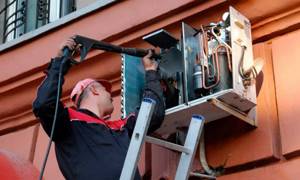
Expert opinion
Nikonorov Vladimir Alekseevich
Our expert. Specialist in the field of air conditioning and ventilation with 10 years of experience.
Ask a Question
Do not attempt to clean the outdoor unit yourself if it is installed at a height. Call specialists, perhaps even industrial climbers.
Remove the top cover of the unit and the fan protective grille. Wear gloves and remove large debris - leaves, branches, etc. Unscrew the fastening nut of the fan impeller and remove it, wash it. Wrap plastic wrap around the engine. Now you can start washing the heat exchanger radiator.
How often should you clean the outdoor unit?
At least twice a year - before and after the season. By removing the casing of the external unit, you yourself will be able to assess the need and scope of work. Be sure to turn off the power before doing this.
Rules for cleaning the air conditioner heat exchanger
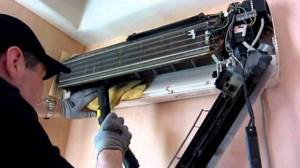
The air conditioner heat exchanger also needs regular cleaning. It looks like a regular radiator. The heat exchanger in various models is located either under a lid that opens, or under filters. The last option is inherent in models with a double air purification system. To clean it, we proceed according to the following scheme: open and remove the front grille of the device, and use a long-bristled brush or vacuum cleaner to clean the radiator fins. We do this slowly and carefully so as not to damage the unit and avoid injury. If the heat exchanger is very dusty, steam cleaning will be required. It is performed only by qualified specialists using their special equipment. The indoor and outdoor units of the air conditioner can be cleaned using a special spray. It has a disinfecting and disinfecting effect. Use it by spraying onto the radiator until it drips onto the floor. Leave the liquid for 2-3 minutes and then repeat the procedure. Then you need to remove the remaining spray from the tubes and body. Remember, you cannot wipe the heat exchanger. Otherwise, you can wrinkle the lamellas and ruin the packing. Excess product should drain naturally.
Cleaning the indoor unit
Cleaning the filter in the air conditioner
Filters come in coarse and fine filter types. The first filter traps dust, debris, dirt, wool, lint, i.e. large particles. Fine filters (usually several of them) remove bacteria, fungi, even tobacco smoke and various microparticles. All this needs to be removed periodically - vacuumed, washed.

How to clean the filter
We disconnect the air conditioner from the network, cover the wall with plastic film so as not to stain it and, if necessary, wear a mask so as not to inhale dust.
We snap off the front panel in the form of a lattice from the block. Through it, warm air enters the unit for further cleaning. Behind the panel there is a coarse or primary filter in the form of a mesh. From time to time you can simply use a vacuum cleaner (dry cleaning), but once every 2-3 weeks you need to wash the filters.
We remove it and soak it. Use a soap solution or a special detergent. You can buy it at the same service center or find it on the Internet. After the dirt comes off the mesh, rinse it with water and let it dry.
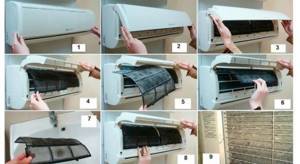
Fine filters are located behind the first filter. Check the instructions to see what filters you have installed. Some of them (coal, for example) need to be purchased and replaced. With the rest, the same procedure is performed as with the coarse filter.
How to clean a radiator and fan
Everything is clear with filters. Next is a fan and a heat exchanger (radiator and evaporator in the form of tubes) with a radiator. The fan causes air to circulate in the room and, of course, dirt gets on it and sticks to it. The heat exchanger cools or warms the air.
Before cleaning and washing, disconnect the drainage tube and remove the tray where condensation accumulates. Unscrew the fastening of the evaporator and the shaft on which the engine rotor is supported. Carefully remove all this and soak it in the same way as the filters. Clean off dirt and let dry.
The drainage pipe that goes from the indoor unit to the street also becomes clogged. First, clean it with a long wire, fill it with washing liquid (for example, chlorhexidine), then dry it (blow it with a vacuum cleaner).
Instructions for cleaning the external unit of the air conditioner
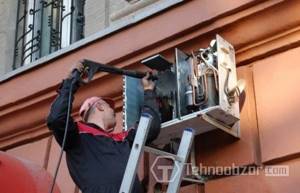
The external unit of the air conditioner, as a rule, is no less dirty than the internal one. Therefore, it also needs regular maintenance. Cleaning work should be carried out a couple of times a year, even if the device is used intensively. A vacuum cleaner is also used for cleaning. Please note that it must be quite powerful. This is the only way he can remove all the dust from the heat exchange radiators and external filters. If the outdoor unit of the air conditioner is located high above the ground, then simply unscrew the grille that protects the inside of the device. Next, we process the internal elements with a vacuum cleaner and wipe with a soft cloth. If this cannot be done, then it is better to hire specialists who remove the device using a tower and thoroughly clean it.
Cleaning your home air conditioner yourself
The more intensively the air conditioner works, and this is mainly in the summer, the more often it needs to be cleaned. If the installation company in the contract indicated this service as free for a certain period, good. If not, then it’s easy to do everything yourself.
By the way, you can observe what service technicians do with your device in this case. The only thing I recommend is that you purchase some cleaning products. The external unit, if it is at a height and it is impossible to get it even from the stairs, you will have to call specialists. It’s easier if you live in a private house, or on the first floor, or the outdoor unit is installed on the balcony.
Automatic air conditioner cleaning

It is performed in a simple way: air flows move idle through the system. This ensures drying of the heat exchanger and various internal parts of the device. Some new air conditioner models use an ion air purification system. A special device helps to bind nitrogen and oxygen ions with dust particles, they are thus charged and “caught” by the dust collector. Some other models use ionized water dust in their work, as well as air mass ionization and multi-stage filtration systems. If the air conditioner has a built-in touch sensor, then the device can independently take into account the composition of the air and start the self-cleaning system at the right time. Maintenance of the latest generation air conditioners has been greatly simplified. However, it should be remembered that no device can reach the filters and wash them with soapy water! Therefore, even innovative systems require manual cleaning. We recommend: Which heat-resistant paint for barbecue is better to choose?
Air conditioning with self-cleaning system

It cannot be said that an air conditioner with a self-cleaning function does not need to be cleaned yourself. Yes, you will have to do this less often, but it is still necessary. Otherwise, the air in such a system passes through the filtration system and dries all its parts.
The ionic cleaning system has proven itself well. And the latest models have smart sensors that can analyze air quality and, if necessary, trigger purification.
How to clean your air conditioner at home yourself: step-by-step instructions for different components
Before you start cleaning your air conditioner, determine the types of work that need to be done. The following processes are carried out independently: cleaning the fan, heat exchanger, filters, drainage.
The outdoor unit also needs cleaning, but it is better to hire a professional to do this job. Working at height is not safe and requires special equipment and experience.
To clean your equipment yourself, you will need the following tools:
- vacuum cleaner;
- soft cloths;
- a small brush (not very wide and with medium bristles);
- Toothbrush;
- detergent;
- soap;
- container with warm water.
Next, self-cleaning of the equipment is carried out in several stages.
Cleaning filters
Cleaning the filters is simple, so everyone can handle this process, the main thing is to follow this sequence:
- You need to open the lid on the top panel.
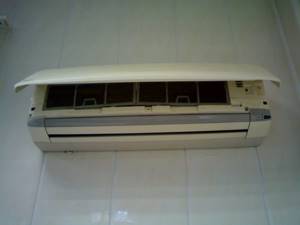
Open the lid on the top panel
- Air conditioner filters are mesh pieces that are carefully pulled out.

We take out the air conditioner filters
- Place soap in a bowl of warm water and wait until it completely dissolves.
- The filters must be placed in the resulting solution for half an hour.

Air conditioner filter cleaner
- After the time has elapsed, check whether any dirt remains on the filters. If so, use a toothbrush to scrub the elements, but do not press them too hard. Running water will help you wash the soapy solution off the filters.
- To remove excess moisture, wipe the parts with a dry cloth or, in sunny weather, leave them on the windowsill.
- Place the filters in their place.
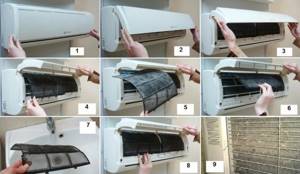
The air conditioner is cleaned in several stages
How to clean the heat exchanger
The heat exchanger affects the quality of cooling and heating of the room, so the procedure for cleaning it should not be ignored.
- First, the internal block in the device opens.
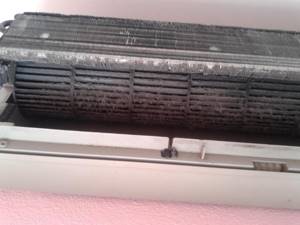
It is also important to clean a dirty air conditioner heat exchanger
- Get the grate.
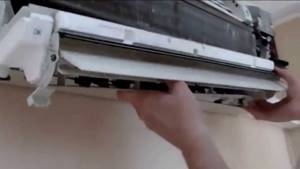
We take out the heat exchanger grille
- Use a vacuum cleaner to collect all the dust from the grate. The vacuum cleaner should operate at medium power.

It is better to clean the heat exchanger with a soft brush.
- Wipe the grill with a slightly damp cloth so that there are no traces of dirt or dust accumulation left later.

Wipe the heat exchanger grill with a rag
- We insert the element into its original place and cover it with a lid.
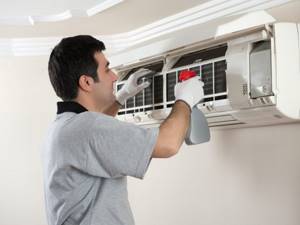
Treating the heat exchanger with an antiseptic
- You need to wait a little before turning on the air conditioner.
How to clean the outside of the device
Also, the external unit of the device needs constant cleaning, although it gets dirty much less than the internal one, so it needs to be removed from dust once every 6 months.
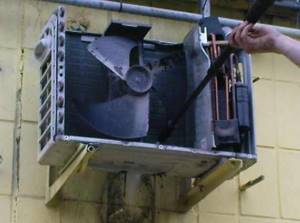
Cleaning the outdoor unit
For the procedure, a powerful vacuum cleaner is used, which is capable of extracting all the dust from the external filters and heat exchange radiator, as well as a soft brush:
- Remove debris. The brush is designed for large debris, and the vacuum cleaner for small debris.
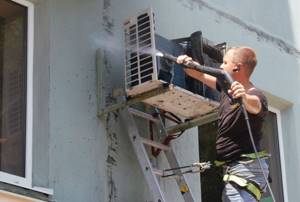
The external unit is washed under running water.
- Remove dirt from the filter grid with a brush.
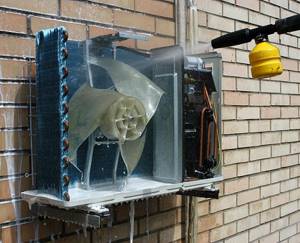
The block is washed with water and a soft brush.
- Reinstall the housing cover.
When the outdoor unit is located within reach for servicing, use a compressor. A hose with a fitting is pushed into the housing and the valve opens. This way you will remove dirt outside the air conditioner grille.
How to clean a fan
The fan is located inside the unit, so you need to open the cover to see its blades. The accumulation of dust on the fan prevents it from working properly. You can remove plaque in this way:
- Turn on the equipment and operate it a little in any mode.
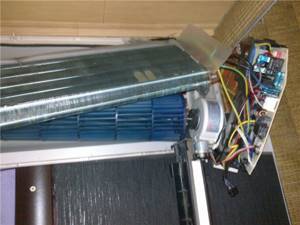
Let the air conditioner run for a while, then turn it off and open it
- Turn off the air conditioner and open its cover. Remove and put it away for a while.
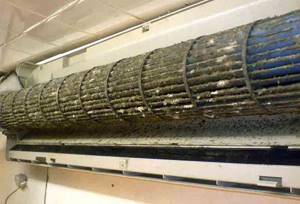
To see the fan of the indoor unit of the air conditioner, remove the cover from it
- Wet a toothbrush in the initially prepared solution of soap and warm water and thoroughly wipe all the blades.

The indoor unit fan is washed with water and a brush.
The fan cleaning procedure must be carried out carefully and thoroughly so as not to damage the blades.
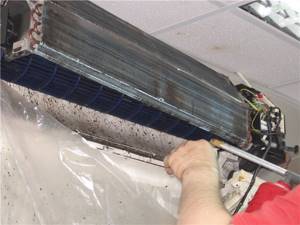
Cleaning the fan from dust must be done carefully and carefully so as not to damage the parts.
Cleaning the drain
The drainage of the device is cleaned using antibacterial treatment. This process includes maintenance of all equipment components. If you have a steam generator, this procedure can be completed much faster.
- First you need to find the entrance to the air conditioner drainage system.
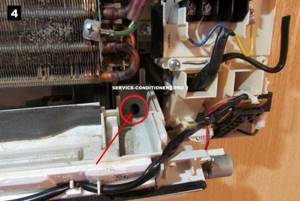
The entrance to the air conditioner drainage system is located on the side under the cover
- Antibacterial cleaning will be completed immediately after the steam unit is blown into the body.

The drainage system is cleaned using steam
- There is a second method - the entire air conditioning system is washed out, after which it is treated with a special antibacterial substance, which is based on alcohol content. This cleaning option involves spraying the substance from a spray bottle.
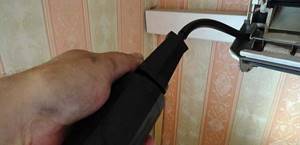
The drainage outlet tube can be washed using a spray bottle.
Prevention of the drainage system
If the air conditioner is used intensively, preventive cleaning of filters and drainage outlets is recommended monthly. To do this, simply rinse the lines with water and some dishwashing liquid. Provided that the system is installed correctly, this preventive maintenance prevents excess dirt from accumulating inside the pipelines.
It is also advisable to inspect the air conditioning turbine monthly. Dirt can collect on the fan blades and mold and mildew can develop. Harmful accumulations worsen the microclimate of the room and cause an unpleasant odor. In addition, they make it difficult for the fan to rotate and can cause the device to fail.
In winter, condensation may freeze inside the drainage channels. It can be removed from there only after the drainage pipelines have warmed up. To insure against such situations, it is important to insulate all condensate drain lines with special heat-insulating materials.
How to Clean an Air Conditioner Drain
At the bottom of the indoor unit there is a condensate drain pan. It can be screwed or fastened with clamps. Take it off. After this you will see a drainage hole. It leads to a tube from which water from air conditioners drips onto our heads.
Drainage pipes often become clogged with small debris. To clean it, take a long cable and start inserting it into the drain hole of the indoor unit. When the end of the cable appears from the drainage tube, pull it out completely and clean it from dirt. Repeat the process several times.
If you have a vacuum cleaner with reverse, you can use it. The only problem is that the diameter of the drainage channel and the vacuum cleaner pipe do not match. But this issue is easy to solve - just wrap a rag or electrical tape around the drainage pipe to increase its diameter.
Once the main contaminant has been removed, it would be a good idea to flush the air conditioner drainage system. For this:
- Fill the drainage with 1-1.5 liters of hot water to wash away the main contamination;
- Pour 50-60 ml of dishwashing detergent into the system;
- Wait 5-10 minutes;
- Pour in another 50-60 ml of detergent;
- Slowly pour hot water into the system until clear water comes out.
This way you can remove the blockage from the air conditioner drain, clean its walls and disinfect them.
Tips and tricks for operating and cleaning the device
The housing, drainage, and filters of the device must be cleaned regularly. This must be done depending on the functional purpose of the equipment and its climatic location:
- it is necessary to clean the outside of the split system, which is located up to the 4th floor, every 3 months;
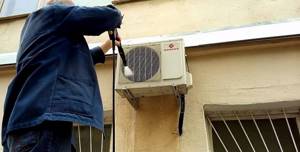
Cleaning the external unit of the air conditioner
- the air conditioner, located from the 7th to 8th floor, needs to be cleaned every few years, since it has almost no contact with organic debris or dust;
- at a height of the 12th floor, equipment needs external cleaning, but not more than once every few years. Therefore, outdoor units of industrial air conditioners are installed on the roof of the building;
- Internal filters are cleaned several times a month;
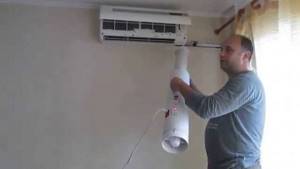
Steam cleaning can be carried out periodically to disinfect the internal filters
- cleaning split systems carried out before the air conditioner is put into operation;

The indoor unit can be cleaned using a steam generator
- In winter, the external unit is constantly cleared of icicles and ice so that they do not damage a parked car or fall on a person passing by.
We recommend: What should be the air humidity in the apartment?
Equipment drains are cleaned as needed. You can check the contamination of the system channels visually by looking at wet spots .
The service life of the equipment depends not only on the chosen model and good installation of the air conditioner, but also on its correct use. By following simple rules, you will extend the operating time of your equipment.
- There should be no drafts in the room where the air conditioner is installed. Close doors and windows to maintain the required temperature, otherwise the equipment will work in increased mode, which will increase the load on the compressor and fan.
- Unnecessarily, do not turn on the air conditioner at maximum airflow, as well as at the minimum temperature setting, since with constant high power operation of the equipment, internal parts will wear out faster.
- The air conditioner must operate at the permitted outdoor temperature: inverter models - from -5 to -10 degrees, equipment with a “winter set” up to -20 degrees, basic models - from 0 to -5°C.
- Servicing must be carried out continuously. For intensive use twice a year, for moderate use - once a year. Specialized companies will charge a relatively inexpensive price for such a service, but this increases the likelihood of preventing serious repairs in the future.
- The indoor unit of the system should not be directly exposed to sunlight.
- After a long period of inactivity, the air conditioner switches to ventilation mode to run the entire system. This will remove accumulated condensation and eliminate unpleasant odors.
- The air flow coming from the air conditioner should not have any obstacles in its path.
- The external unit must be protected from exposure to precipitation. For example, make a canopy that will prevent snow and rain from falling on the block. You can also install an anti-vandal grille.
- Once a quarter, clean the air conditioner filters, dry them and put them back in place.
You can not only extend the operation of the air conditioner, but also make the equipment less dirty. To do this, follow these rules:
- Ventilate the room periodically while using the equipment;
- do not place foreign objects on the air conditioner and its indoor unit;
- containers with water and flowers also do not need to be placed on the equipment;
- do not touch the equipment with wet hands;
- do not let animals sit on it.
Features of operation of the air conditioner
The purchased equipment has the service life of the air conditioner specified by the manufacturer. However, the user can handle the equipment in such a way that its wear will be reduced and the operating time will be significantly extended. To do this, you need to follow the rules of careful handling of the air conditioner:
- It is necessary to ensure that there are no drafts in the room where the device is used. If this is not done, the air conditioner will not be able to provide the desired temperature and will work intensively. This will result in significant additional load on the compressor and fan.
- When working, it is not recommended to frequently use modes that require extreme voltage from the equipment. This will lead to constant intensive work and reduce the service life of the fan working units. It is recommended to avoid setting the lowest temperature or maximum airflow mode.

Cleaning the external unitSource konder-samara.ru
This might be interesting! In the article at the following link, read about how to install an air conditioner.
- The operation of the air conditioner in winter conditions is designed for a certain temperature range. Conventional models are designed for a range from -5 to 0 degrees, inverter models - from -5 to -10, equipment using a “winter set” - up to -20 degrees.
- During operation, it is necessary to comply with the service periods. It is usually done annually. However, if there is intensive use, servicing is required twice as often. This will cost much less than repairs.
- It is necessary to exclude the situation when the indoor unit is constantly exposed to direct sunlight.

Cleaning using a special brushSource media.home.co.id
- If it so happens that the air conditioner has not been used for a long time, then when you turn it on for the first time, you must use it in ventilation mode. During operation, it will dry completely and after that it can be used in operating mode. This will completely remove condensation and there will be no unpleasant odor during operation.
- The air conditioner must be installed in such a way that the air flow from it should not encounter any obstacles along its path.
- The external unit, being outdoors, is exposed to weather and precipitation. If you protect it from rain and snow, this will increase its service life. A good solution would be to make a canopy over it to protect it from rain.
You can extend the life of the device not only through careful operation, but also by ensuring cleanliness and order in the room. To do this you need to do the following:
- Ventilation is recommended when the equipment is used.

Flushing the air conditionerSource openoblokah.ru
- Avoid placing foreign objects, including water containers or flowers, on the air conditioner or indoor unit.
- Do not touch the device with wet hands.
Taking good care of your equipment will ensure that it will serve you well for a long time.
In what cases can you not do without a service center?
When buying an air conditioner, be prepared for the fact that in some cases you will not be able to do without service. There are several reasons that will force you to turn to specialists:
- The air conditioner stopped turning on;
- some functions stopped working;
- the device turns off on its own;
- water drips from the indoor unit;
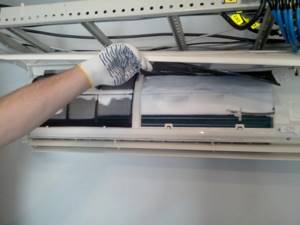
If water drips from the indoor unit of the air conditioner, you should contact a service center
- the drainage tube does not produce condensation;
- There is no cooling when the air conditioner is running;
- after turning on the air conditioner, your eyes begin to water, weakness or a sore throat occurs.
You cannot eliminate any of these reasons yourself, which means you cannot do without service.
Video: how to clean the external unit of an air conditioner with your own hands
Now you already know how to maintain an air conditioner, but the process of cleaning various parts must be carried out carefully, since you can damage the equipment or injure yourself. What can we say about the fact that a badly damaged element will have to be replaced. Also make sure that after cleaning, the air conditioner parts dry thoroughly. Comprehensive maintenance will help you use your air conditioner for a long time.
Signs of contamination
If the air conditioner filters are dirty, then not only the operation of the device itself suffers, but also the quality of the air output. Without proper care, fungi and harmful microorganisms appear inside the air conditioner, which are carried throughout the apartment by air flow and ultimately enter the human respiratory tract. You can tell if your air conditioner is dirty by several signs:
- The most striking indicator is an unpleasant odor immediately after starting the system; this may also indicate obvious problems with drainage.
- When the power of the air conditioner decreases and energy consumption increases, you should pay attention to the indoor unit, there is a high probability of severe contamination.
- A condensate leak, even the smallest one, indicates obvious problems with the split system, which are associated with untimely cleaning.
- Any uncharacteristic noises, crackles and hums from the air conditioner indicate the right time for cleaning.
However, you should not wait for all the above signs and ensure regular maintenance and cleaning of the air conditioner. If the split system operates daily for a long time, then this event should be carried out as often as possible.
INFORMATION:
Untimely cleaning can not only lead to damage to the air conditioner, but also negatively affect human health. The most common diseases with a contaminated split system are: bronchitis, allergies of various types, asthma, pneumonia, dry skin, and frequent headaches.
Air conditioner cleaning products
Before work, prepare gloves, a brush, a vacuum cleaner, a rag, a bucket, and a sprayer. A regular soap solution is suitable for cleaning the air conditioner. They can easily wash the housing (plastic, metal), filters, grilles, fan.
For a heat exchanger with a radiator, a special cleaning agent is better suited. There are many of them on the Internet. The choice is large both in price and in properties. These are all kinds of aerosols in the form of sprays in cylinders or liquids in sprayers. Such products will also help get rid of dirt, mold, grease, and unpleasant odors.
Using aerosols is simple: apply, wait 10-15 minutes, ventilate the device in ventilation mode. Sprayers with liquid or foam: apply, wait until the dirt falls off, rinse, dry.
Cleaning products
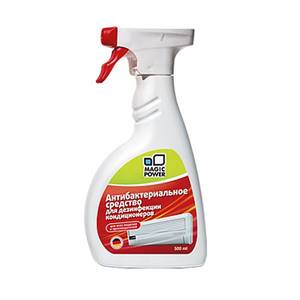
Antibacterial cleaners are designed to disinfect the insides of the air conditioner. They are sold in aerosols, so they are easy to use - they create a strong pressure that penetrates deeply.
Foam solutions are intended for cleaning the heat exchanger. Easy to apply, then turns into a liquid state. They are washed off with water or wiped with a rag, depending on the instructions in the instructions.
Products contain chlorine, alcohol, weak active substances, acids. They differ in purpose. Some substances can be harmful, so they are allowed to be used when there are no people in the room. The person doing the cleaning wears protective gloves and a mask that covers the respiratory system. This applies to acid-containing products. It is not recommended to use chemicals in children's rooms.
After applying chemicals, turn on the air conditioner to thoroughly ventilate the indoor unit and remove volatile substances.
Anti-corrosion agents are used together with cleaners. Especially useful if the air conditioner is installed outdoors with heavy traffic. Car gases contain substances that destroy the thin layer of protection, so it is periodically restored with acrylic-based products that extend the life of the external device.
Frequently encountered problems
How the filter protects the air conditioner and the room from dirt and dust is already known. But is it necessary to take any measures not only for cleaning, but also for maintaining the device for efficient and long-term operation?
Of course, it is necessary. Firstly, experts recommend that the device be prepared for the summer season. This is due to the fact that you will need to technically prepare the air conditioner. In summer the air is much more dusty than in winter.
Very often, owners complain that the device has stopped cooling the air. The most common cause is a refrigerant leak from the appliance. The primary factor here is to find out the cause of the breakdown.
Many owners of split systems are faced with the problem that they cannot determine when exactly the filter needs to be cleaned. It is worth noting that almost all modern devices are equipped with indicators that show the degree of filter contamination.
If this indicator is missing, then you should rely on the average optimal period, which is determined by the manufacturer, approximately 1 month.
Do not forget that the filters in devices are different. For example, pocket filters are completely disposable and should never be washed like mesh filters. Such an element will have to be completely replaced after it reaches its maximum.
Thus, by setting your priority cleaning times, you can always be sure that your air conditioner is operating efficiently. By carrying out preventive maintenance on time, you can be sure that your device perfectly cleans and cools the air in the room, and dust, dirt, bacteria and fungi do not accumulate in the cleaning elements.
Preventing air conditioner contamination
There are rules, following which, you can avoid excessive contamination of the air conditioner and extend the service life of the device:
- Immediately after purchasing the equipment, you must enter into a service agreement with a service company. During the warranty period this service will be free of charge. Preventive maintenance performed at regular intervals will prevent many problems.
- If deviations from the norm are found during the operation of the equipment, you should not try to find the fault on your own, but trust the professionals.
- When cleaning the air conditioner yourself, you must use only special products and tools recommended for this type of equipment.
- When removing particularly heavy contaminants, it is recommended to use a steam generator, which is capable of not only effectively removing dirt, but also carrying out additional sanitary treatment of the insides of the equipment.
- Connecting equipment to the network after cleaning can only be done after all mechanisms and units are dry.
- In order for the device to serve for a long time and without problems, you need to carefully study the operating instructions from the manufacturer and strictly adhere to the instructions listed in it.
Recommendations for preparing a split system for winter/summer
Preventative maintenance work (cleaning, disinfection and replacement of filter elements) is often tied to the change of seasons, especially in regions with a continental climate.
Manufacturers limit the operation of equipment depending on the outside temperature. It is prohibited to operate air conditioners at low temperatures, so before the onset of cold weather it is recommended to thoroughly clean the unit and dry it thoroughly.
You also need to prepare the air conditioner for the beginning of the warm season after winter. The indoor unit is cleaned of dust accumulated during the cold period, and the condition of the filter and fan is checked. After the flowering season of poplars and other trees, it is recommended to clean the outer unit again from fluff.
Video: Practical recommendations for cleaning the air conditioner
Sources
- https://4shop.ru/article/clean-air-conditioning-filters/
- https://stroyday.ru/remont-kvartiry/ventilyaciya/chistka-kondicionera-svoimi-rukami.html
- https://www.ivd.ru/stroitelstvo-i-remont/tehnika/kak-samostoyatelno-pochistit-kondicioner-doma-podrobnaya-instrukciya-dlya-mojki-vnutrennego-i-vneshnego-bloka-59441
- https://tehnoobzor.com/tests-reviews/home_appliances/492-remont-i-obsluzhivanie-kondicionera-svoimi-rukami.html
- https://aqua-rmnt.com/ventilyaciya/kak-pochistit-konditsioner-doma-samostoyatelno.html
- https://slgaz.com/2017/11/kak-prochistit-drenazh-kondicionera.html
- https://ventilation-conditioning.ru/remont-i-ukhod/kak-pochistit-kondicioner.html
- https://oventilyatsii.ru/kak-pochistit-filtr-v-kondicionere.html
How do you like the article?

Sergey Vladimirovich
Ask a Question
Air conditioner maintenance equipment
Due to the affordable cost of services for servicing cooling machines and the fairly high cost of the equipment necessary to perform this work, it is not advisable to purchase special tools and materials for inspecting 1 - 3 air conditioners.
List of special equipment used in the maintenance process:
- Mini high pressure washer. A device designed for deep cleaning of machine parts (housing, crankcase, etc.), external and, in some cases, internal heat exchanger. A low-power station with a jet nozzle is suitable for washing. Powerful mini-washers cause deformation of the heat exchanger plates.
- Steam generator. A device that generates steam with a temperature of about 120 degrees. Celsius, used to clean the heat exchanger, turbine from dirt and mold.
- Set of screwdrivers, pliers, adjustable, hex keys. The listed tool is used to disassemble the air conditioner housing, check the amount of freon, etc.
- Electrical extension cord. A 15 - 25 m long wire with a plug and socket is used in cases of cleaning the air conditioner outdoors or placing a power point at a remote distance.
- Gauge manifold. It is used to check the amount of freon in the system and the quality of vacuuming.
- Leak detector. Device for examining gas leaks. Instead, you can use a hand sprayer filled with soapy water.
- Electronic clamps. Tester for checking the current load of the compressor.
- Compressed air cylinder. The device is used to clean the drainage tube. For a small drainage area, up to 6 m, with one turn, you can use a cable or wire.
- A product for cleaning the air conditioner from dirt and mold. Liquid for combating allergens that arise during condensation stagnation. Also, some chemical reagents can remove contamination of heat exchangers.
- Safety system. When working at height, for safety reasons, you must have a minimum set of climbing equipment: figure eight, carabiners, anchors, and a safety belt.
- Ladder. Used to service an outdoor unit located on the 1st or 2nd floor (depending on the length of the stairs and the base).
- Vacuum pump. In cases where the evaporator is dismantled for cleaning under pressure, it is necessary to disconnect and then connect the units with evacuation of the internal line.
- Hammer. Attaching anchors for the safety system.
The listed equipment for servicing the air conditioner should be provided by a specialist who professionally deals with split systems. With the convenient placement of the outdoor unit, high-quality system components and the tightness of the freon pipe, to carry out maintenance it is enough to have the tools indicated in positions 1 - 8.
When and why you need to clean air conditioning equipment
As a rule, the situation when you have to clean a household split system arises extremely rarely: that’s all you need, but how to clean it, yourself or with the help of a specialist, or call a specialized team from a cleaning company for such a case - this is the question that worries the user most often. This article is intended to answer several common questions related to cleaning air conditioners, what you can do on your own, and where professional intervention is required.
First of all, you need to answer the question: “Why do you need to clean the split system yourself?” Of course, for these purposes you can call a specialist and pay him several thousand hard-earned, but why pay for something that is no more difficult to do than cleaning, for example, a vacuum cleaner. Few people call a specially trained person for this.
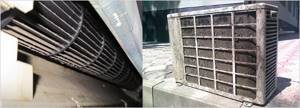
In an air conditioner that has not undergone a preventive maintenance procedure for a long time, a lot of dust has accumulated inside, which will certainly lead to problems, namely:
- Significant deterioration of the indoor microclimate. Dust that settles on the air conditioner units will spread throughout the room, which can cause allergic attacks in people in the room. You can read how to check the air in an apartment in the article “Effective methods for analyzing air in an apartment.”
- Difficulty in the operation of this climate control device. The thing is that accumulated dust and dirt in the filter elements will prevent the free passage of air flow.
- Significant reduction in air conditioner efficiency. These are the consequences of dust buildup on the heat exchanger.
- Increased risk of failure of the split system due to increased air resistance and, as a consequence, increased load on the fan motor.
Often asked
Do air conditioners with an automatic cleaning system need cleaning?
The automatic cleaning system cannot remove contaminants adhering to structural elements, although it significantly reduces the rate of their accumulation. Therefore, such split systems also need to be cleaned, although less often.
Is it possible to do without disinfectant solutions if a steam cleaner is used for cleaning?
Superheated steam also has a disinfecting effect, but does not have the same spectrum of action as special chemicals. Therefore, for high-quality cleaning, it is not recommended to abandon the latter.
How to clean electronic components?
You cannot do this yourself. Servicing electronics is a task for specially trained service center personnel, otherwise the risk of control system failure increases dramatically.
Is it possible to speed up the drying process by running the unit's fan?
This method cannot be used; water may get on electronics or live parts of the circuit.
Why can't filters be wiped after washing?
Mechanical stress can remove the active coating of the filters, in which case the components will have to be replaced.

